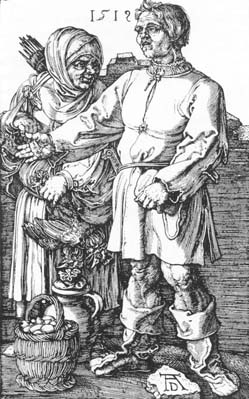
Expropriation of the land had three results:
The expropriation of land and the bloody legislation against the expropriated produced not only a proletariat available for work in capitalist industry, but also a market for the goods being produced by that industry. Previously, that market was quite limited because most people produced what they needed. It was restricted to the wealthy with money to spend or to local exchange, often under conditions of barter or reciprocity within a community. Marx points out that the rise of a waged working class also meant the rise of a class of consumers who increasingly bought everything they needed in the market.

For most people involvement with the market in pre-capitalist times was marginal. In Albrecht Durer's 1512 etching we see his portrayal of two peasants at the market. You will note that they have but a few items to sell. Similarly, those doing the buying would also buy little of what they needed.
As we saw in Chapter 28, throwing peasants off the land does not necessarily mean they will present themselves at the factory gates or constitute an immediate market for capitalists' goods. The inability to produce one's own food or clothing does not mean those who need to eat or to be clothed will have the money necessary to buy what they need or that buying them is the only way to obtain them. They could also be appropriated directly. In legend, Robin Hood and his merry men poached the king's deer. As commons were enclosed, peasants continued to gather wood in forests for huts and fires and poached game on now private land.(1) Along with the laws against vagabondage, aimed at creating a class of waged workers, came other laws aimed at preventing such direct appropriation, i.e., property laws that imposed the market as the only legal way to acquire goods. These laws were every bit as bloody, perhaps more so, than those against vagabondage. In the 17th and 18th Centuries, British courts regularly hanged people for petty "theft." Historian Peter Linebaugh coined the term "thanatocracy" for this rule by death.(2)
While this distinction between direct appropriation and buying with a wage may seem clear cut, historically it was not so neatly defined. During the period of manufacturing, it was commonplace in many trades, for the workers to take part of their income in the form of directly appropriated means of production. For example, silk workers would appropriate scraps of silk cloth, shoemakers would keep excess leather, shipwrights would help themselves to scrap lumber, sailors would take tobacco being transported in their ships, cowboys could take part of their pay in calves or put their own brand on mavericks, and so on. In each case the workers would either consume the material directly, sell it for money or work it up into a product (e.g., leather into shoes) and sell that for money.(3) Eventually, this kind of activity was criminalized; laws were passed attacking these non-wage forms of income and through them the real wage was lowered, making the workers poorer and the employers richer. Moreover, the struggle over such appropriation led to a variety of new methods of production: from hogsheads (large wooden barrels) in shipping (to make "pilfering" more difficult) to Mirabeau's fabriques réunies in which workers could be watched over, their labor process more carefully controlled and "waste" limited.
Another way of looking at the emergence of the "home market" is the
commodification of production, that is so say how goods which had been produced
for use, came to be produced for sale. This is characteristic of the capitalist
organization of life: capitalists convert human activities into commodity producing
ones. The people capitalists put to work, produce not just useful items but items
or services but commodities that can be sold to make a profit (or so the capitalists
hope. This whole process of putting people to work producing commodities, sold to
realize a profit, which is then reinvested to begin the whole process over again,
Marx calls (in Chapter 7) “valorization” or the
“self-valorization” of capital.(4)

Capitalist valorization is quite the reverse from the point of view of displaced peasants and artisans. Peasants displaced from the land lose their ability to farm, not only in the direct sense that without land they cannot grow food, but over time the very skills necessary for farming are lost within a generation. Their children, raised away from the land, never acquire the skills of their parents. Artisans, who knew how to spin thread or weave cloth but lost their spinning wheels and looms, soon lose their skills in those handicrafts. Their children never gain them. Thus, the creation of value for the capitalist means the creation of what Ivan Illich has called “disvalue” for the expropriated.(5) This loss of skill, this loss of the ability to produce for oneself to meet one’s own needs, involves two related processes, devalorization and disvalorization. Where certain skills and abilities and knowledges are lost completely, not just by the individual but by society, we can say there has been devalorization or the destruction of value. Where the skills and abilities are lost to individuals but taken over and incorporated into capital and the production of commodities, we can say the people have suffered disvalorization—the displacement of personal and communal skills into the production of commodities.(6)
These processes, although begun in the earliest period of primitive accumulation, continue to this day. In Chapter 15 of Capital, on machinery and modern industry, Marx analyzes this process in terms of deskilling. He shows how the development of machines has involved the mechanical reproduction of skills that workers then no longer exercise. The more this process develops, the fewer aspects of traditional skill are exercised by workers. The result is a real process of "abstraction" through which work is steadily reduced to simple machine tending.
Today, the processes of devalorization and disvalorization are most evident in the Global South. In barrios and villages, we find people whose abilities to meet their own needs are being undermined by the intrusion of the market. Sometimes, as in the case of the substitution of marketed baby formula for breastfeeding, the results have been dramatic: malnourishment, crippling and even death.(7) In other cases, say the substitution of store-bought clothing for homespun, the results are not so immediately obvious or dramatic but, in the long run, cultural traditions and ways of life are lost, e.g., patterns unique to communities woven into clothing, traditional reverence for the earth. The creation of the home market replaces diverse cultural practices and ways of being by a single way of doing things and similar goods. Capitalists like to point with pride to the array of colors and styles available in your average department store, or the array of foods available in supermarkets. But compared to the pre-existing diversity of styles in clothing and cuisines, their vaunted "choices" pale, mere variations to maximize sales.
Under these circumstances, people have long fought against the subordination of their activities to capitalist accumulation and for the preservation of their cultures, which cannot survive independently of the structure of those activities. Just as peasants struggled against the expropriation of their land, so too did the artisans among them struggle against the destruction or subordination of their tools and crafts. As described in Chapter 15, during the early period of manufacture workers sometimes smashed machines that would subordinate their skills, increase their work and lower their income.(8) Such struggles also constituted a defense of ways of life, of patterns of interactions, within a community and between generations (parent-child, apprenticeships).
Looking primarily at Europe, Marx saw the rigidities of the guilds with their strict rules that limited production, the number of journeymen working under a master, and so on. In those conditions, he saw capitalism bringing a certain freeing up, a liberation of production from artificial restraint, thus an historically progressive force. But the guilds were mainly city institutions and Marx never closely explored the great variety of cultural practices in the countryside&mdashh;at least not until late in his life, long after Capital was written. Then, he began to read ethnographic studies and was drawn into debates about the Russian mir, or peasant commune. As a result, he showed a greater appreciation of such alternative forms of social organization. Unfortunately, none of this shows up in Capital; it was never revised to take account of this new appreciation.
Marx does address a fundamental difficulty inherent in the rise of an industry based on a labor force separated from the land. If expropriation led to a fall in production of foodstuffs, because of fewer people working the land and agrarian capitalists replacing food production with raw material production for multiplying factories, there would be a serious problem in feeding those forced off. However, he was aware of two factors that tended to offset such a difficulty. First, England had increasing recourse to importing foodstuffs from the continent.(9) Second, the concentration of the land in the hands of an emerging capitalist class was accompanied by an increase in agricultural productivity, an early “green revolution” that involved innovations such as crop rotation, the spreading use of nitrogen-fixing crops, drainage, land reclamation and water meadows.(10) These improved methods were implemented primarily by the greater cooperation and intensity of work by wage laborers under the control of agrarian capitalists. Under these circumstances, the “setting free” of part of the agricultural population was accompanied by a similar “setting free” of part of the product of the soil, now sold in the market to those forced into the cities.(11)
Increased productivity has often been used as a justification
for changes in land tenure by policymakers in Western capitalist countries as well
as by those in the Soviet bloc who imposed collectivization. But two points temper
this rationale. First, it is easy to find many areas of the world where land was
expropriated but then not cultivated at all and so productivity did not rise. In
some cases, the land was monopolized purely with the intent of preventing the
indigenous population from having recourse to subsistence farming. Examples are
common in Central America. When the CIA overthrew the government of Guatemala in
1954, it was partly because its democratically elected president, Jacobo Árbenz
Guzman (1913–71), had appropriated unused lands of the United Fruit Company
for distribution to landless peasants.(12)
In other areas, expropriated lands have been used productively and then abandoned
but not given back to their original owners, e.g., in the Brazilian northeast
where, when the price of sugar dropped, sugar cane lands were abandoned. In the
Soviet Union and other so-called socialist countries, peasant resentment and
resistance to forced labor systematically undermined the productivity of the
state or collective farms.


Second, the basic argument that changes in land tenure can raise productivity is, itself, questionable. Questionable not because data on productivity, such as pounds of wool per acre or per hour of labor, do not show a rise, but because of the narrow notion of productivity. Traditional self-sustaining agriculture has almost always involved a complex mix of interrelated activities— well-known in traditional American family farming that long dominated US agriculture. The traditional family farm engaged in both cropping and husbandry. Corn provided food for the table, feed for cattle as well as marketable produce. Cattle provided milk and milk by-products, meat, income through the sale of meat and hides as well as fertilizer for the fields. Rotated nitrogen fixing crops such as alfalfa or clover provided feed for the cattle as well as fertilizer to the soil. Gardens provided a balance of vegetables and fruit for the table, and sometimes for sale in local markets. Pigs absorbed table waste while producing meat for consumption or sale, and so on. The replacement of a large number of such farms by a few commercial agribusiness operations that produce just one crop, such as hybrid corn, or feedlot cattle or pigs, has involved the substitution of a simple monoculture system, whose productivity is narrowly defined and easy to measure, for a complex system whose productivity is not so simply measured, or even conceptualized. That complex system was a way of life that integrated humans and nature as well as nature itself.(13) Destroying such ways of life replaces complex, balanced ecosystems by simplified, unbalanced ones, often with disastrous consequences for the land, for water and for human life. (14) In short, the decline of traditional farming involved tremendous human and ecological costs in terms of the destruction of ways of being that could not be legitimately compared with or compensated for by increased productivity. What has been true in the United States has also been true around the world, from the destruction of Mexican milpas and communities to the commercialization of Asian wet-paddy rice culture..
home market manufactures reunies destruction of handicrafts imperialism disvalorization devalorization
|
1. What was the relationship between agricultural production and artisan manufacture in the period before the expropriation of the agrarian population?
2. What are the processes Marx cites through which the agricultural revolution raises output on the land? In what sense was the agricultural revolution a technological one, in what sense a social one and how were these two related?
3. Explain what it means to say that the means of subsistence were "set free" at the same time the workers were. Is this as simple as it sounds?
4. What does Marx and Mirabeau's discussion of the factory tell us about its initial form and origins?
*5. In footnote seven (on p. 912 of Vintage ed.) Marx extends the discussion from the creation of the "home" market to that of the foreign market—a moment of analysis of "imperialism." How might protection (limiting competing imports) hasten the separation of agriculture and domestic industry as Marx suggests?
*6. Discuss the process of disvalorization as presented in the commentary. Can you observe this process in the world around you? What about in school? What abilities and skills do children sometimes acquire independently of school which are then undermined by the structure of school?
2 See Linebaugh, The London Hanged, Chapter Two: "'Old Mr Gory' and the Thanatocracy."
3 Linebaugh analyzes several of these situations, both the direct appropriation that supplemented money wages and its criminalization. Ibid., Chapters 5, 8 and 11. See also Allen, Chapters in the History of Organized Labor in Texas.
4 As opposed to the self-valorization of workers. In the Introduction to Reading Capital Politically, I point out how this term “self-valorization” was appropriated and redefined by the autonomist Marxist Antonio Negri to designate, not the self-valorization of capital, but the self-activities of workers valorizing their own lives.
5 On the concept of disvalue, see Ivan Illich’s essay “Useful Unemployment and its Professional Enemies” in his book Towards a History of Needs, Berkeley, CA: Heyday Books, 1977.
6 For further methodological considerations on valorization and disvalorization, see Harry Cleaver, “The Inversion of Class Perspective in Marxian Theory: from Valorization to Self-Valorization”, in Werner Bonefeld, Richard Gunn and Kosmas Psychopedis (eds.), Open Marxism, vol. 2, Theory and Practice, London: Pluto, 1992, pp. 106–144.
7 Such results led to an international boycott of Nestle for pushing baby formula to the poor in the Global South and to the formation of the International Baby Food Action Network (IBFA).
8 Capital, Vol. I, pp. 554-555.
9 102. With England in the lead in the development of manufacturing, many countries on the continent, from Revolutionary France to Czarist Russia exported grain to England in order to buy manufactured goods, including machinery to expand their own industry. This would only pose a problem in times of war, e.g., the Napoleonic Wars (1803–15) when grain imports were cut off.
10 See G. E. Mingay, Agricultural Revolution: Changes in Agriculture, 1650–1880, London: A & C Black Publishers, 1977.
11 This history was forgotten by economists who expected, after World War II, to be able to move some 25 percent of the agricultural labor force in Eastern Europe into manufacturing labor with no reduction in output. They were wrong and soon had to revise their plans to include increased investment in agriculture to raise productivity. See Paul Rosenstein-Rodan’s classic “Problems of Industrialization of Eastern and South-Eastern Europe”, Economic Journal, Vol. 53, no. 210/211, 1943, pp. 202–211. A later example of the less optimistic efforts to find ways of imposing work is John C. H. Fei and Gustav Ranis, Development of the Labor Surplus Economy: Theory and Policy, Chicago, IL: Homewood, 1964.
12 Richard H. Immerman, The CIA in Guatemala, Austin: University of Texas Press, 1982. Also see the now released CIA assassination plans for the overthrow of the Arbenz government and the "cleansing" of his supporters.
13 See Wendell Berry, The Unsettling of America: Culture & Agriculture, Berkeley, CA: Counterpoint, 1977, 2015.
14 Examples include the impoverishment of the soil by monocropping, the runoff of excess inorganic fertilizers into waterways causing eutrophication and the overuse of pesticides poisoning workers in the fields, consumers and a variety of non-human an-mals, most recently honeybees, whose colony collapses are threatening entire industries requiring them for pollination.